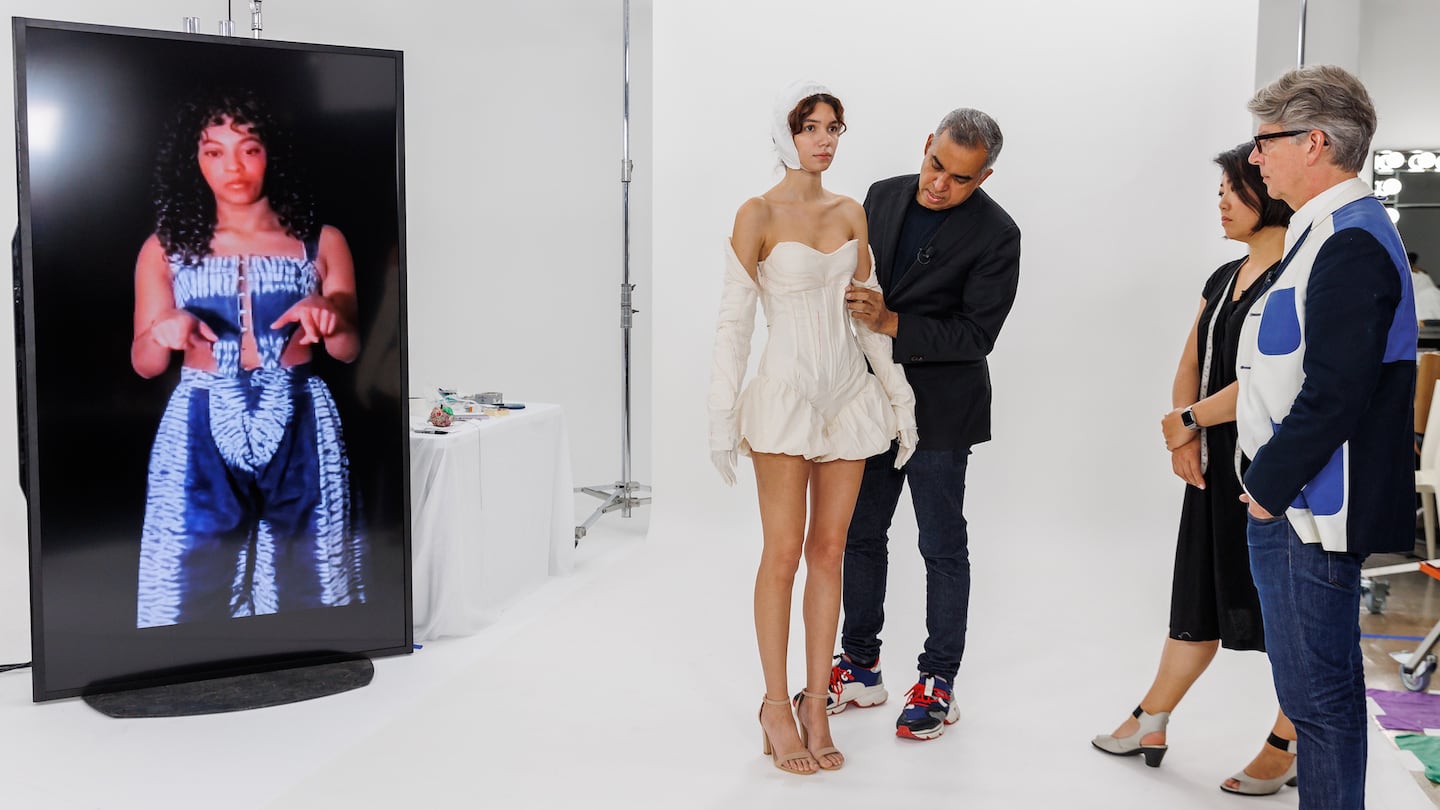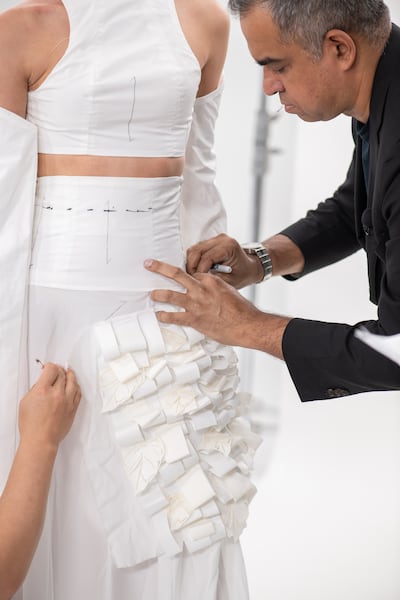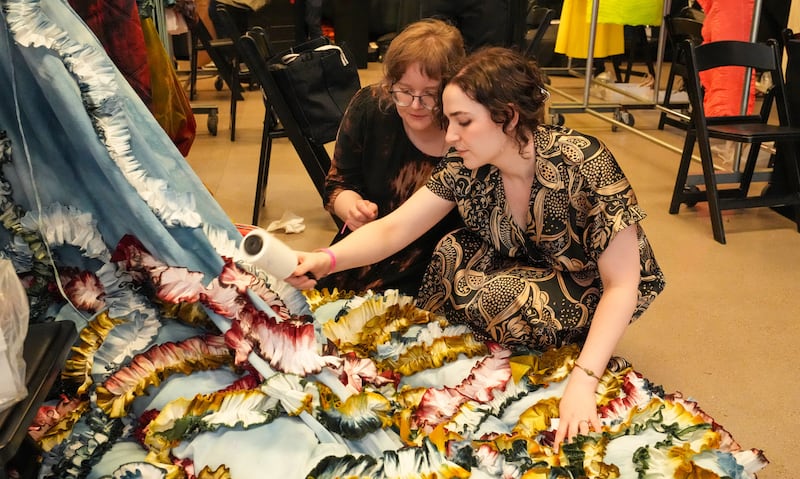
The Business of Fashion
Agenda-setting intelligence, analysis and advice for the global fashion community.

Agenda-setting intelligence, analysis and advice for the global fashion community.

Now in its 16th edition, the Supima Design Competition returns this year to champion the next generation of design talent and expand its supportive network of young fashion creatives with a focus on innovative, sustainable materials.
The competition showcases the work of eight graduating designers from leading fashion schools across the US, offering a platform to demonstrate their technical and creative potential at both New York and Paris fashion weeks, along with a prize of $10,000.
Charged with picking this year’s winner and host of the competition is cult designer and former creative director of Moschino, Jeremy Scott, who shared: “I’ve been happy to be a small part of helping bring new talents to the larger public’s awareness on the past two seasons of Amazon Original’s ‘Making the Cut.’ So, it was a great honour to be asked to host the Supima Design Competition’s Sweet 16th.”
“Through our competition, we want to help elevate designers, particularly young designers, offering them a gateway into the industry,” Buxton Midyette, the VP of marketing and promotions at Supima, told BoF. “They bring their creativity, their training and their lack of preconceived notions to the competition.”
Founded in 1954, the Supima brand — an abbreviation of “Superior Pima” — promotes a variety of Pima cotton grown exclusively in America. A non-profit organisation, Supima works on behalf of 300 family farms across the west and south west of the country, which harvest a cotton whose fibre is on average 1.27cm (0.5 inches) longer than regular cotton. This produces a stronger fabric which retains its shape and colour more effectively, becoming softer after each wash and reducing piling.

Supima’s high performance originally lent itself to industrial materials, previously used in car tyres and aviation fabrics. Indeed, the Spirit of St. Louis, the aeroplane flown by Charles Lindbergh in 1927 from New York to Paris, was wrapped in Supima cotton, owing to its durability and lightweight quality. However, it is the contemporary, creative potential of Supima that the event aims to elevate.
What began as a small, local competition in its first three years quickly evolved into an international event. Supima began by working with four design schools on the East Coast of the US, largely around New York. Soon after, the competition expanded to the Midwest followed shortly by California and has since become a renowned opportunity to spotlight some of the talent ascending through the top design schools in the country, offering these creatives a space to demonstrate their vision for the future of fashion.
As a design student, procuring materials in small batches can be one of the most challenging aspects of developing a collection, an obstacle Supima helps to overcome by providing fabrics in shorter lengths. The partnerships also permit Supima to partake in conversations surrounding sustainability by hosting talks with their partner fashion schools on the impacts of cotton manufacturing.
The competition then challenges the contestants to make a capsule women’s eveningwear collection exclusively from Supima cotton. The contestants are provided with five fabrics from Supima’s licensed manufacturers: denim, twill, corduroy, knit and velveteen. Each designer must make one look from each of the fabrics.
In the hands of these newly graduated designers, cotton becomes a blank canvas, and so we see them approaching the five fabrics with such creativity and innovation.
“This really represents a snapshot of what the next generation of designers is thinking,” said Midyette. “In the hands of these newly graduated designers, cotton becomes a blank canvas, and so we see them approaching the five fabrics with such creativity and innovation. If you remove the preconceptions of its traditional usage, you can understand the potential for impressive manipulations of fabric, distressing and hundreds of different treatments.”
Mentorship, support and industry connection play significant roles in the competition’s foundation. Alumni candidates are invited to all Supima-hosted events to foster connections among young talent. Designers have often ended up working in the same design houses, cultivating fertile ground for connections with their co-workers.

Midyette describes the competition process as like a “mini Master’s programme”, supporting candidates every step of the way. For the three months following their graduation and before displaying their collections during New York Fashion Week and then in the Design Lab in Paris, designers are each assigned a mentor who supports them on a weekly basis. The mentor guides them from initial sketches to the final show and in the creation of a professional portfolio. Returning for a ninth season as mentor to the finalists is eveningwear designer Bibhu Mohapatra, who has dressed the likes of Jennifer Lopez and Michelle Obama, and won a Council of Fashion Designers of America (CFDA) award.
BoF spoke to the eight finalists from this year’s competition to discuss their experiences of working with Supima fabrics and how that lends itself to their development as emerging designers today.
0 of 8
Sahara Clemons studied at the Rhode Island School of Design in New York, specialising in knitwear and trouser design. Clemons is focused on recent discoveries of unconventional, natural materials such as mushroom leather, and feels it important to consider environmental costs when it comes to textile production.
“My main hope for the future is that we can go back to more traditional fashion production methods but streamline more innovative fibres. As there are more developments like mushroom leather or spider silk yarn, we will be closer to finding sustainable solutions to fashion’s pollution problem. I am now shifting my ideation process to prioritise ethics as much as storytelling.
“The different properties of the Supima fabrics influenced my designs — I wanted to highlight each fabric’s unique properties, such as the stiffness of denim or the airiness of shirting. However, I also wanted to treat each material in a way that felt atypical of its conventional usage, like turning velveteen into a bodycon jumpsuit or creating a denim puffer dress.”
Specialising in Fashion and Costume Design at the School of Art Institute of Chicago, Mariana Espinosa uses fabric to determine the direction and mood of her collections, which is particularly relevant to her work in costume design and textile development.
“During the early stages of my research and concept development for a collection, a mood starts to emerge. The weight, form and feel of the fibres reflect this mood. For the Supima competition, the real challenge was making a cohesive collection with five different fabrics of diverse weights and textures.
“Because of this, more focus went into the colour selection and the balancing of silhouettes. My practice highlights natural dyeing, making fibre selection incredibly important. The natural dyeing process is a careful chemistry that requires each fibre to be treated and prepared in a specific way for the best colour output.”
Specialising in eveningwear during her Bachelors in Fashion Design at the Fashion Institute of Technology in New York, Hee Jin Hwang founded her own label alongside her studies. Hwang explores the overlap between fashion and science in her designs and ponders technology’s potential to shape the future of fashion.
“Even though I was always interested in textiles, I didn’t have many chances to develop it from scratch. Instead, I purchased interesting fabrics from the store. Through this competition, I was able to push the boundary and experiment a lot — I tried so many different types of fabric manipulation and now I’m confident in developing plane fabric into textured fabric.
“I recently saw a video about how soft robotics-mixed fabric can be used to help disabled people, which was intriguing to me. I want to study fabric development more, or even fabric’s tech side, and hopefully collaborate with engineers on this in the future. I feel that Supima cotton fibre could be mixed with soft robotic fibres to create interactive fabrics, developing a fun project for the future.”

Amber Kuai studied at the Academy of Art University in San Francisco, majoring in Fashion Design. Kuai focuses on using unconventional materials in a couture collection to redefine luxury and the process of designing high fashion ensembles.
“Often, when people think of eveningwear, they think of shiny and dramatic fabrics that provide a certain stereotype. However, Supima encourages us to push the boundaries in this respect and to try unexpected silhouettes.
“Different fabrics have distinct performances, and this is always the first thing that comes to my mind when developing a collection. The way they drape and flow, everything about fabrics can determine how the final design will look like. Cotton has a modest finish even when it’s processed to produce textural materials, but this semi-matt feature actually lets our final looks stand out from regular garments.”
Having majored in Fashion Design at Drexel University in Philadelphia, Carla Pierini has developed a strong interest in sustainability, posing questions through her work on her social and environmental responsibility as an emerging designer.
“Fashion needs to become more circular — waste is a design error. We as designers have the power and the duty to ask deeper questions in this respect — the future of fashion depends on how we are able to answer those questions.
“In terms of materials, cotton will still be a key player, and has always been my go-to fabric. It allows me to look closer into how far I can take fabric properties. For example; how instead of making jersey react like a woven, I can embrace the one-way stretch to create volume. Every fabric supplied to us for the competition has different properties and from the beginning I considered their properties in order to develop the concept.”
Having studied at Kent State University in Ohio, specialising in womenswear, Wendy Weng developed an interest in natural fibres and their potential to host symbols of growth and regeneration.
“Natural fibres, such as cotton, offer numerous environmental advantages as they require less energy and leave a smaller carbon footprint compared to synthetic alternatives. In contrast, synthetic fibres are often sourced from non-renewable resources and release harmful chemicals during production.
“I did not expect to use cotton in eveningwear, but the end result was exceptionally fitting. The quality of Supima cotton allowed each fabric to go through multiple dye baths, treatments and washes, and still retain its quality and durability. The comfort has also not been compromised through this process.”

Having graduated from the Parsons School of Design in New York this summer, Tianze Wu is leveraging the Supima Design Competition as an opportunity to focus on the creative potential and challenges of more sustainable fabric.
“As I worked on this project, I realised that I shouldn’t be overly focused on the idea of competition. It’s a unique opportunity to showcase China’s centuries-old dyeing techniques in a post-modern way to the world — I’ve used plant-based dyes for the whole project — persimmons, pomegranates, lotus flowers, even insects and minerals.
“Considering the fibres is really important. Some fabrics had a bit of stretch because they contain rubber, which gives them a nice elasticity. Figuring out how to make the most of that bounce in my design was a big deal.”
Alexander Ziemba completed his Bachelors in Design at the University of San Francisco before attending the Fashion Institute of Design and Merchandising, Los Angeles, to complete a one-year Masters programme in Fashion Design. In LA, Ziemba came to specialise in womenswear, experimenting with shape and form.
“Fibre consideration is always important in the design process. Knowing how fabrics behave in response to their fibre content is necessary for anyone who wants to be a designer. The look has to accentuate the fabric, and in turn the fabric has to reinforce the look.
“The competition forces you to think outside of the box, encouraging you to question how far you can push this fabric, how you can make this more interesting. But you also have to understand that cotton has its limits. The competition makes you design with intention.”
This is a sponsored feature paid for by Supima as part of a BoF partnership.
Europe’s Parliament has signed off rules that will make brands more accountable for what happens in their supply chains, ban products made with forced labour and set new environmental standards for the design and disposal of products.
Fashion’s biggest sustainable cotton certifier said it found no evidence of non-compliance at farms covered by its standard, but acknowledged weaknesses in its monitoring approach.
As they move to protect their intellectual property, big brands are coming into conflict with a growing class of up-and-coming designers working with refashioned designer gear.
The industry needs to ditch its reliance on fossil-fuel-based materials like polyester in order to meet climate targets, according to a new report from Textile Exchange.